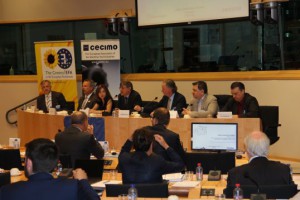 How to achieve the full-scale industrialisation of additive manufacturing (AM) in a rapid and cost-effective manner whilst generating the highest value for society. High level representatives from industry, academia, EU institutions, think tanks and standardisation organisations discussed at the “Additive Manufacturing European Conference” organized by CECIMO, the European Association of the Machine Tool industries, at the European Parliament in Brussels on 23 June.
How to achieve the full-scale industrialisation of additive manufacturing (AM) in a rapid and cost-effective manner whilst generating the highest value for society. High level representatives from industry, academia, EU institutions, think tanks and standardisation organisations discussed at the “Additive Manufacturing European Conference” organized by CECIMO, the European Association of the Machine Tool industries, at the European Parliament in Brussels on 23 June.
The Conference confirmed that AM creates perspectives in terms of technology, markets and economic development, as well as sustainability. The design freedom brought by AM stretches the imagination of designers and engineers to develop highly functional products which respond to complex customer needs. Moreover, layer-by-layer production generates unprecedented savings on material and energy usage, making AM a blueprint for sustainable and competitive manufacturing.
Jean Camille Uring, CECIMO President said: “Additive manufacturing can satisfy Europe’s appetite for innovation and can boost the added value of industrial production. AM is still a relatively young technology which needs to be further developed so that its full potential can be unleashed. Europe has to move fast amidst global competition to turn AM into a mainstream technology that serves multiple sectors.”
It was recognised that AM is an integral part of the digitisation trend in manufacturing. AM allows to convert digital data into products whilst disrupting existing production processes and supply chains. Supply chains are shifted to the virtual environment and the storage requirements are reduced to the hardware necessary to store files. By promoting mass-customization and on demand-production nearby customers, AM can become a key driver of Europe’s reindustrialisation. At the conference, strong emphasis was put on the impact of AM on the society. Although industrial AM applications find their way across sectors such as automotive and energy, the aerospace and medical sectors appear to be the two main early adopters. Lightweight construction of air vehicles allows saving thousands of tons of emissions every year.
The strongest message that came out of the Conference was a call to the EU to adopt a “European strategy for Additive Manufacturing” which bridges complementary capabilities and resources across Member States. It was highlighted that such a strategy should look beyond research funding so as to accelerate the market uptake of AM, including standardisation, finance, awareness raising, skills, IPR, liability as well qualification and certification procedures. Especially, standards will be instrumental to build market confidence in this new technology. Education and skills appear to be the key enabler of AM market uptake. Innovation in AM is driven by usage, therefore, it is essential to place AM in education curricula, and to give students and the industrial workforce access to hands-on training. Designers and engineers will be the ones to set free the transformative power of AM across sectors, be it machine tools, aerospace or automotive.




[…] is actively driving the industrialisation of the Additive Manufacturing process to meet the volume and quality standards expected by the automotive industry – previously […]